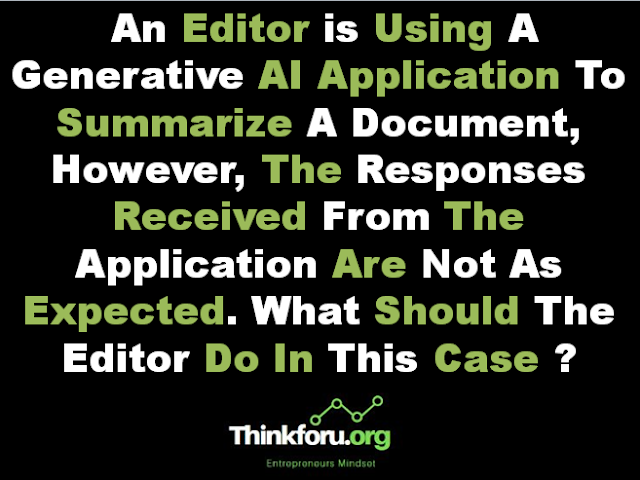If the responses from the generative AI application are not as expected, the editor can take several steps to improve the summarization process:
1. Review and Understand the Document:
Make sure the editor has a clear understanding of the content in the document. This will help in evaluating whether the generated summaries are accurate and relevant.
2. Provide Clear Instructions:
Check if the editor has provided clear and specific instructions to the AI application. Providing guidelines, keywords, or specifying the desired length of the summary can help the AI generate more relevant responses.
3. Experiment with Parameters:
Some AI applications allow users to tweak parameters like the length of the summary, level of detail, or focus on certain aspects. Experimenting with these parameters can yield better results.
4. Use Multiple Attempts:
If the AI application allows it, try generating multiple summaries and compare them. This can help in identifying common themes and key points.
5. Post-Processing:
After receiving the AI-generated summary, the editor can manually review and edit it to ensure accuracy and coherence. This step is important to refine the output and make it more suitable for the intended purpose.
6. Consult Documentation or Support:
Check if there is documentation or support resources provided by the AI application. It may contain additional tips, best practices, or troubleshooting steps.
7. Feedback to Developers:
If the issues persist, providing constructive feedback to the developers of the AI application can be valuable. They may be able to make adjustments or provide guidance on how to improve results.
8. Consider Alternative Solutions:
If the AI application consistently fails to meet expectations, consider exploring alternative generative AI tools or approaches to find a better fit for the summarization task.
9. Verify Input Quality:
Ensure that the document being summarized is of good quality and clarity. If the input document is ambiguous or poorly written, it may affect the performance of the AI summarization.
10. Stay Updated:
Check if there are any updates or new versions of the AI application. Developers often release improvements and updates that can enhance the performance of the model.
Here are a few considerations for the editor:
11. Use Pre-trained Models or Custom Training:
Depending on the AI application, consider whether it uses pre-trained models or if there's an option for custom training. Custom training on specific domains or topics may lead to more tailored and accurate summaries.
12. Evaluate Domain Specificity:
Some AI models are trained on general data, while others may be specialized for certain domains. Check if the AI application is designed for the type of content in the document. If not, look for domain-specific models.
13. Check for Limitations:
Be aware of any limitations mentioned by the AI application's developers. Some models may struggle with certain types of content or may not perform well in specific scenarios.
14. Collaborate with AI:
Collaborative editing with the AI system may help improve results. The editor can work with the AI, providing feedback or clarifications, to refine the summarization output.
15. Explore Ensemble Approaches:
Combining the results of multiple AI models or summarization techniques (ensemble approaches) can sometimes yield more robust and accurate summaries.
16. Consider Human Assistance:
In cases where the AI application consistently falls short, involving human assistance or expertise in summarizing key points can be a viable solution.
17. Adjust Expectations:
It's essential to have realistic expectations about the capabilities of the AI application. If the document is highly complex or nuanced, the AI may struggle to capture all relevant details accurately.
18. Test with Various Document Types:
Test the AI application on a variety of document types to understand its strengths and weaknesses. Different models may perform better on certain types of content.
19. Explore Post-Processing Tools:
Utilize post-processing tools or techniques to further refine the generated summaries. This can involve manual editing, using other automated tools, or employing specific summarization algorithms.
20. Seek Community Input:
If the AI application has a user community or forum, consider seeking input from other users who may have faced similar challenges. They may provide valuable insights and solutions.
The effectiveness of a generative AI application can vary depending on the specific use case and the quality of input data. Experimenting, providing feedback, and exploring different strategies will contribute to enhancing the summarization process.
By taking these steps, the editor can optimize the use of the generative AI application for document summarization and achieve more accurate and relevant results.
